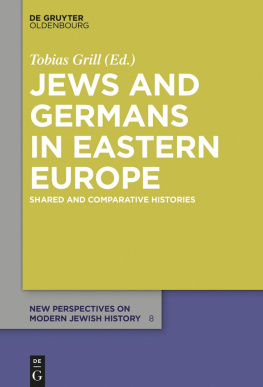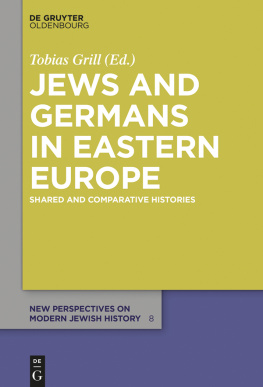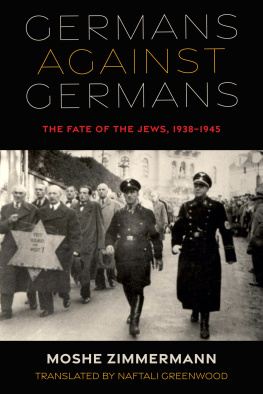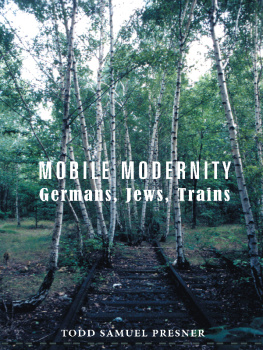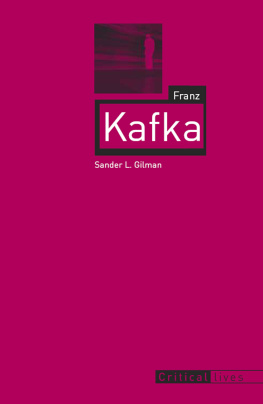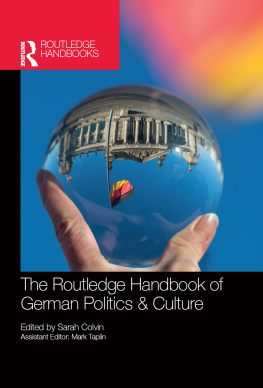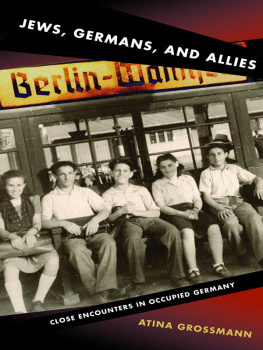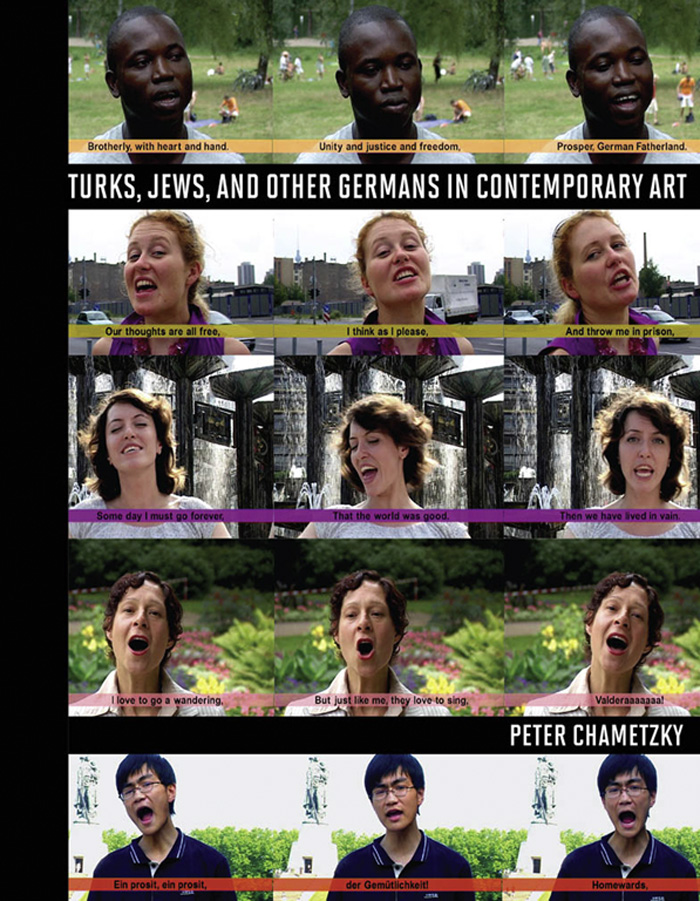
Turks, Jews, and Other Germans in Contemporary Art
Turks, Jews, and Other Germans in Contemporary Art
Peter Chametzky
The MIT Press
Cambridge, Massachusetts
London, England
2021 Massachusetts Institute of Technology
All rights reserved. No part of this book may be reproduced in any form by any electronic or mechanical means (including photocopying, recording, or information storage and retrieval) without permission in writing from the publisher.
The MIT Press would like to thank the anonymous peer reviewers who provided comments on drafts of this book. The generous work of academic experts is essential for establishing the authority and quality of our publications. We acknowledge with gratitude the contributions of these otherwise uncredited readers.
Publication of this book has been aided by a grant from the Millard Meiss Publication Fund of CAA.
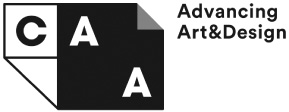
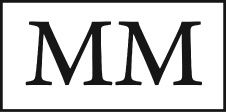
This book was set in Arnhem Pro and Frank New by New Best-set Typesetters Ltd.
Library of Congress Cataloging-in-Publication Data
Names: Chametzky, Peter, 1958- author.
Title: Turks, Jews, and other Germans in contemporary art / Peter Chametzky.
Description: Cambridge, Massachusetts : The MIT Press, [2021] | Includes bibliographical references and index.
Identifiers: LCCN 2020031714 | ISBN 9780262045766 (hardcover)
Subjects: LCSH: Arts, German21st centuryThemes, motives. | Cultural pluralism in art. | Cultural pluralismGermanyHistory21st century.
Classification: LCC NX550.A1 C46 2021 | DDC 700.943dc23
LC record available at https://lccn.loc.gov/2020031714
10987654321
d_r0
For Sue
The urge to migrate is no less natural than the urge to settle.
Kwame Anthony Appiah, Cosmopolitanism: Ethics in a World of Strangers (2006)
One might argue, in fact, that it is simply irresponsible for European states to continue to allow significant segments of their populations to be driven by nostalgia for homogeneity. There is no longer room to pretend that European countries will return to some imagined, idealized state of ethnic and cultural sameness.
Rita Chin, The Crisis of Multiculturalism in Europe (2017)
Contents
Acknowledgments
This book has been long in the making. Much has changed in the world and in my life during this period. Research for it began in 20112012, when I was ending fourteen wonderful years as an art history professor in the School of Art and Design at Southern Illinois University, with the final four years as director of that school. I thank all my friends and colleagues over the years in Carbondale, including Bob Paulsen, Harris Deller, Kay Pick Zivkovich, Anna Brzyski, Carma Gorman, Stacey Sloboda, Michael Batterman, Elina Gertsman, Angela Reinoehl, Sandra Charlson, Najjar Abdul-Musawwir, Jonathan Wiesen, Natasha Zaretsky, and deans Shirley Clay Scott, Alan Vaux, and Kimberly Kempf-Leonard.
In 20122013 my wife Susan Felleman and I took positions at the University of South Carolina. I am grateful to Dean Mary Anne Fitzpatrick, Associate Dean Anne Bezuidenhout, and the College of Arts and Sciences for providing generous research funding that enabled trips to Germany to conduct the research, visit with artists, and see the work that laid the foundation for this book. I thank my current dean, Lacy Ford, and Associate Dean Cynthia Davis for continuing support from the college, as well as my friend, colleague, and fabulous successor as director of the School of Visual Art and Design, Laura Kissel, for all of her work and support on behalf of me and the entire school. My colleagues in art history, Lydia Brandt, Bradford Collins, Susan Felleman, Andrew Graciano, Anna Swartwood House, and Amanda Wangwright, have attended research presentations and provided valuable feedback. Thanks to Carma Gorman, Rich Kemp, and Marius Valdes for technical support.
I was honored to present on this topic at an April 2016 symposium at the City University of New York Graduate Center honoring my PhD advisor, Rose-Carol Washton Long. I am grateful to her for the invitation as well as for her support both then and over the years. Maud Lavin also presented that day, and her enthusiasm for this project and the books title has been unwavering and energizing. While my 1991 dissertation was on a totally different topic, the influence of its other readersRosalind Krauss, Linda Nochlin, and Rosemarie Blettercan be found in this book, as can that of many of my truly extraordinary fellow students at the Graduate Center in the 1980s. When I was an undergraduate at Cornell, Robert Hobbs introduced me to contemporary art in class and as his assistant at the Herbert F. Johnson Museum of Art.
I thank Nathaniel B. Jones and James P. Anno for inviting me to present on Maziar Moradis work at the 2018 College Art Association meeting. I learned much from my fellow Time, Space, and Movement panelists, Carla Benzan, Henrike Christiane Lange, and Michelle Oing. I wish to thank Nicole Coleman and Sabine Doran for their responses to my paper on zlem Gnyol and Mustafa Kunt at the 2019 German Studies Association meeting. In fall 2019 I was invited by the Columbia World Affairs Council to give a talk on German art since 1989. Thanks to Dickson Monk and Wim Roefs for the invitation, and to Eileen Blyth, Diko Pekdemir-Lewis, and Michael Stoeltzner, among others, for attending and responding. I was also invited that fall to deliver the keynote address at the annual Graduate Art History Student Organization symposium at the University of North Carolina, Chapel Hill. I thank Andrea Snow and her colleagues for the invitation and their responses. Other attendees and respondents that day whom I thank include Andrew Bynom, Holly Hurlburt, Paul Jaskot, Jules Michael Terry, and James Van Dyke. For his generous introduction, I thank Peter Nisbet.
Professor Dr. Verena Krieger of the Friedrich-Schiller University, Jena, kindly invited me to present there in the fall of 2018. The response I received from her, her colleagues, and students was most helpful. At that time, I was on sabbatical in Berlin, supported by a grant from the Deutscher Akademischer Austauschdienst (DAAD), which was crucial to the completion of this project. I am grateful to Professor Dr. Charlotte Klonk for facilitating my becoming a fellow of the Institute of Art and Image History at Humboldt University and to her colleagues Margarete Pratschke and Jitske Jasperse as well as the institute staff for their help and hospitality. Fellow fellows Kathryn Brush, Kristina Jekalda, and Jeffrey Saletnick provided great intellectual vibrancy and comradery. In Berlin, thanks also to Dorothea Schne of the Kunsthaus Dahlem and Rita Burster of Galerie Rita Burster. I benefited from the ambience and the books in the apartment of my Berlin landlord, Professor Robin Ostow. I thank Berlin friends Lisa Shoemaker and Kristina, Nikita, and Ananda Vaillant for the sustenance they provided then and at other times. Elsewhere in Germany, my thanks go out to Felicitas Baumeister, Hadwig Goetz, Jutta Pilgrim, Ulf Reichardt, Karsten Reichmann, Oliver Sukrow, Cristjane Schuessler, and Hans Jrg Schttler.
Students in three semesters of my course at the University of South Carolina, Art in Germany since 1937, helped me to develop my ideas. I especially thank those who in spring 2020, after we switched to an online format, read and commented on chapters 1 and 5, to the benefit of both: Tegan Campbell, Kendall Farmer, Caroline Frady, Lilly Leaphart, Elizabeth Wright, and Anny Wu. In earlier semesters, Audrey Martinichs work on Hito Steyerls
Next page

